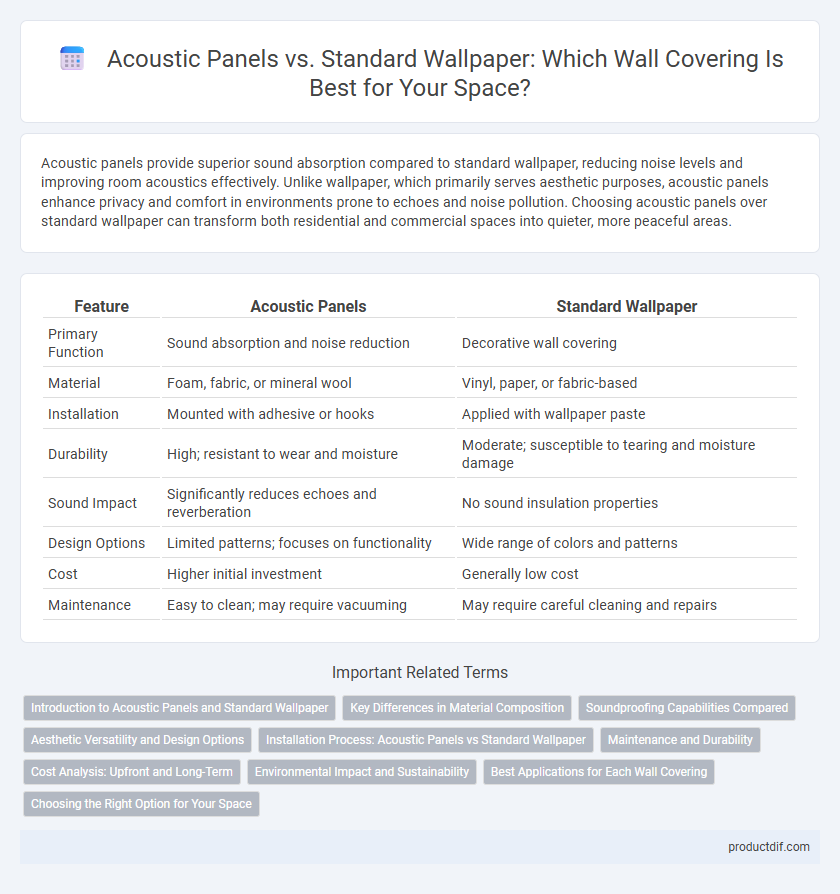Acoustic panels provide superior sound absorption compared to standard wallpaper, reducing noise levels and improving room acoustics effectively. Unlike wallpaper, which primarily serves aesthetic purposes, acoustic panels enhance privacy and comfort in environments prone to echoes and noise pollution. Choosing acoustic panels over standard wallpaper can transform both residential and commercial spaces into quieter, more peaceful areas.
Table of Comparison
| Feature | Acoustic Panels | Standard Wallpaper |
|---|---|---|
| Primary Function | Sound absorption and noise reduction | Decorative wall covering |
| Material | Foam, fabric, or mineral wool | Vinyl, paper, or fabric-based |
| Installation | Mounted with adhesive or hooks | Applied with wallpaper paste |
| Durability | High; resistant to wear and moisture | Moderate; susceptible to tearing and moisture damage |
| Sound Impact | Significantly reduces echoes and reverberation | No sound insulation properties |
| Design Options | Limited patterns; focuses on functionality | Wide range of colors and patterns |
| Cost | Higher initial investment | Generally low cost |
| Maintenance | Easy to clean; may require vacuuming | May require careful cleaning and repairs |
Introduction to Acoustic Panels and Standard Wallpaper
Acoustic panels are specialized wall coverings designed to absorb sound and reduce noise levels in indoor environments, improving room acoustics and speech clarity. Standard wallpaper primarily serves decorative purposes, adding texture and color to walls but offering minimal sound attenuation or acoustic benefits. Choosing acoustic panels enhances sound quality in spaces like offices, studios, and theaters, whereas standard wallpaper focuses on aesthetic appeal without impacting acoustic performance.
Key Differences in Material Composition
Acoustic panels are composed of specialized sound-absorbing materials such as foam, fiberglass, or mineral wool designed to reduce noise and improve room acoustics. Standard wallpaper typically consists of paper or vinyl layers primarily intended for aesthetic purposes without sound insulation properties. The key difference lies in the functional materials: acoustic panels prioritize sound dampening through porous, dense structures, whereas wallpaper focuses on visual appeal with lightweight, non-absorptive materials.
Soundproofing Capabilities Compared
Acoustic panels are specifically engineered with sound-absorbing materials like fiberglass or foam to significantly reduce noise and echo, outperforming standard wallpaper which offers minimal soundproofing. Acoustic panels improve room acoustics by dampening sound waves and minimizing reverberation, ideal for recording studios or noisy environments. Standard wallpaper primarily serves decorative purposes and lacks the density and structure necessary to effectively block or absorb sound.
Aesthetic Versatility and Design Options
Acoustic panels offer superior aesthetic versatility compared to standard wallpaper, featuring a wide range of textures, colors, and customizable shapes that enhance both functionality and visual appeal. Unlike traditional wallpaper, acoustic panels can be tailored to fit modern, minimalist, or eclectic design themes while improving room acoustics. Their ability to blend sound absorption properties with artistic patterns makes them a preferred choice for stylish, noise-controlled environments.
Installation Process: Acoustic Panels vs Standard Wallpaper
Acoustic panels installation involves mounting pre-fabricated sound-absorbing materials directly onto walls using adhesives, brackets, or hooks, often requiring precise alignment for optimal acoustic performance. Standard wallpaper installation requires preparing the wall surface, applying adhesive evenly, and carefully smoothing the paper to avoid bubbles or wrinkles, which can be time-consuming and labor-intensive. Acoustic panels offer a quicker, less messy installation process compared to traditional wallpaper, making them ideal for both residential and commercial soundproofing projects.
Maintenance and Durability
Acoustic panels offer superior durability compared to standard wallpaper, resisting wear, moisture, and fading over time. Their maintenance typically involves simple dusting or vacuuming, eliminating the need for frequent replacement due to damage or stains. Standard wallpaper often requires careful cleaning and may peel or discolor, leading to higher long-term upkeep costs.
Cost Analysis: Upfront and Long-Term
Acoustic panels typically present a higher upfront cost compared to standard wallpaper, ranging from $50 to $150 per panel versus wallpaper prices of $0.50 to $5 per square foot. Long-term investment in acoustic panels pays off by enhancing sound insulation and reducing noise pollution, potentially lowering heating and cooling expenses due to added insulation benefits. Standard wallpaper requires more frequent replacement or repairs, which can accumulate higher maintenance expenses over time despite its lower initial cost.
Environmental Impact and Sustainability
Acoustic panels typically offer better environmental benefits than standard wallpaper due to their use of recycled or natural materials like hemp, cork, and recycled polyester, which reduce waste and carbon footprint. Standard wallpaper often relies on PVC and PVC coatings that contribute to pollution and are less biodegradable, impacting landfill sustainability. Choosing acoustic panels with low VOC emissions enhances indoor air quality while supporting eco-friendly building practices.
Best Applications for Each Wall Covering
Acoustic panels excel in environments requiring sound absorption and noise reduction, such as recording studios, home theaters, and office spaces where controlling echo and improving acoustics is essential. Standard wallpaper is ideal for aesthetic enrichment in residential and commercial spaces, offering a wide range of textures, patterns, and colors suitable for living rooms, bedrooms, and lobbies. While acoustic panels prioritize functionality in sound management, wallpapers focus on decorative appeal and design versatility.
Choosing the Right Option for Your Space
Acoustic panels provide superior sound absorption and noise reduction, making them ideal for spaces requiring enhanced acoustics such as home theaters, offices, or recording studios. Standard wallpaper primarily serves decorative purposes and offers minimal impact on sound control, best suited for aesthetic enhancements in living areas or bedrooms. Assess room function, noise levels, and design preferences to determine whether the functional benefits of acoustic panels outweigh the visual versatility of traditional wallpaper.
Acoustic Panels vs Standard Wallpaper Infographic

 productdif.com
productdif.com